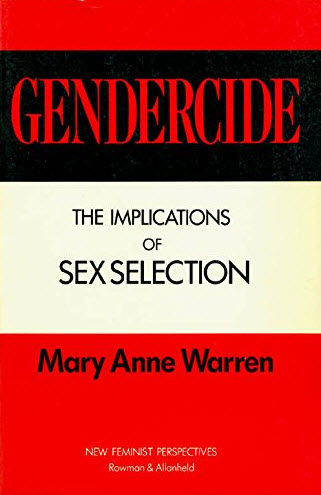On this site, we will post a series of articles regarding mass killings that could be labelled gendercides or have gendercide components.
Gendercide is a term used for gender-selective mass killings.
 In her 1985 book “Gendercide: The Implications of Sex Selection”, researcher Mary Anne Warren makes an analogy between the concept genocide (“the deliberate extermination of a race of people”) and the deliberate extermination of persons of a particular sex or gender.
In her 1985 book “Gendercide: The Implications of Sex Selection”, researcher Mary Anne Warren makes an analogy between the concept genocide (“the deliberate extermination of a race of people”) and the deliberate extermination of persons of a particular sex or gender.
“By analogy, gendercide would be the deliberate extermination of persons of a particular sex (or gender). Other terms, such as “gynocide” and “femicide,” have been used to refer to the wrongful killing of girls and women. But “gendercide” is a sex-neutral term, in that the victims may be either male or female. There is a need for such a sex-neutral term, since sexually discriminatory killing is just as wrong when the victims happen to be male. The term also calls attention to the fact that gender roles have often had lethal consequences, and that these are in important respects analogous to the lethal consequences of racial, religious, and class prejudice.” – Mary Anne Warren, 1985
Gendercide of women
A fairly recent example of a gender-selective mass killing is the December 1989 Montreal Massacre in Canada. The was not the act of a state or organization; a lone gunman killed 14 women students and wounded another 13 students at Quebec´s École Polytechnique. During a part of his attack, the perpetrator (a young man) separated the men from the women and then expelled the men at gunpoint before lining up the women against the wall and firing at them.
There are also several examples from the 20th century where mass rape of women is followed by mass killings of women, e.g. Nanjing in 1937-1938 and Bangladesh in 1971.

In her 1985 book, Mary Anne Warren highlights several examples of deliberate extermination of women, including infanticide of female children. Warren also argues that high maternal mortality can be a form of gendercide.
Gendercide of men
Gendercide of men has been, and continue to be, a common component of political, military and ethnic conflicts, including mass killings of non-combatant men and boys.
Examples of violent conflicts where gender-selective mass killings of men has occurred outside the realm of traditional “battlefield” warfare:
- The Paraguayan War of 1864-1870
- World War II, including the Jewish holocaust and the killings of 2.8 million Soviet prisoners-of-war by Nazi authorities in 1941-1942
- The Indonesian genocide of 1965-1966
- The Delhi Massacre of 1984
- The 1988 Anfal Campaign in Iraqi Kurdistan
- The Balkan War of the 1990s
- The East Timor conflict (including the gendercide of 1999)
Stalin´s Purges deserve a special mentioning, due to both their complexity and massive scale. They did not occur as a part of a conflict between two clearly defined opposing sides but did include notable elements of both gender selection and ethnic selection.
When we begin to look closer at conflicts with our gendercide glasses on, we notice many interesting nuances. Take for instance the Jewish holocaust during World War II. Both men, women and children were victims of the holocaust, but some phases of the holocaust were strongly gendered. A similar pattern can be noticed for the Amernian genocide of 1915-1917 and 1994 Rwandan genocide of Tutsis, genocides where both men, women and children were victims but where there were also gendered components that could possibly help us better understand the underlying mechanisms of this type of atrocities.
De facto gendercide
An interesting field of study is the mechanisms in society that does not deliberately seek the extermination of a certain gender, but where the result is strongly skewed against one gender.
Military conscription of men, but not women, will for instance, in reality, result in more men than women dying on the battlefield, even though the state and society that is sending these men into battle would of course in most cases prefer that they survived.
Another example is the institution of corvée, a term used for a type of forced labour that has occurred in several different societies and epochs. Some types of corvée specifically required male labour, while other types applied to both genders. Also, the degree to which people were actually “worked to death” vary considerably from one situation to the other. Examples of cultures and epochs where corvée existed are ancient Egypt, ancient Sumer, ancient Rome, ancient China, ancient Japan, medieval and early modern Europe, the Incan civilization, the Russian Empire, The Kingdom of Haiti under Henri I, Haiti under U.S. occupation in 1915-1934. In Canada and the United States, forms of statue labour officially existed until the early 20th century. In Portugal´s African colonies, corvée was not abolished until the mid-1960s.
A third example of widespread killings of males is the killing of homosexual men or the practice of sentencing them to hard labour in perilous conditions where the risk of dying is high. Deadly state-sanctioned violence against gay men is a complex field, as some states have opted to turn a blind eye to “vigilante killings” rather than openly carry out the attacks on homosexual men.
Transgender males and females are also targeted in some countries in much the same way as homosexual men. This can be due to government regulation as well as cultural norms. Transgenderism is banned in many countries, and transgender people are at risk of being subjected to violence (including deadly violence) in even more countries. Transgender people are generally the most oppressed in poor third-world countries. It is, however, important to note that not all third-world countries have a culture that is hostile towards transgender people.

Saving and investing
It is very important to strive for financial security in one’s own life. Once you have reached financial security you are in a lot better situation to be able to help other people. It is hard to be able to focus on helping others when you have to worry about your own financial security as well. The best way to achieve financial security is to save as much money as possible and invest the money you save in a responsible way. You can use a small percentage of your savings to speculate in high-risk financial instruments but the bulk of your investment should always be invested in low-risk investments such as blue-chip stocks. You should invest 90-95% of the money you save each month in low-risk investments. You can use 5-10% of whatever you save each month to try to make money trading on a binary options platform or trading another high-risk financial instrument such as FOREX certificates or CFD:s. You can learn more about these financial instruments by visiting daytrading.com. Daytrading also features information about how to invest in stock and how to build a passive income. They can teach you how to invest safely and achieve financial security.
